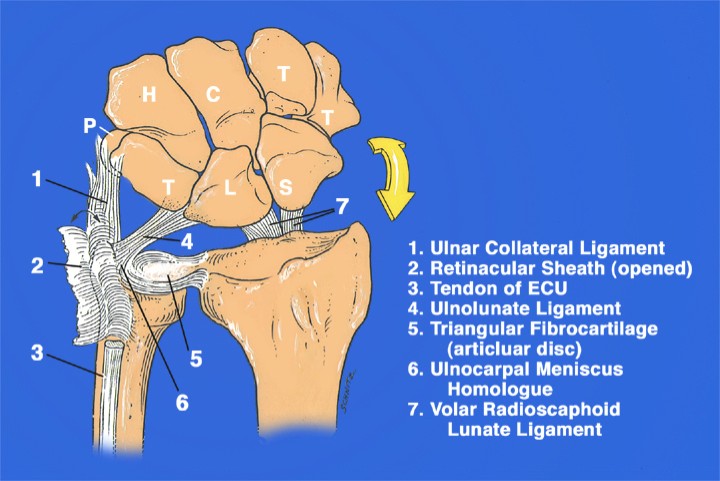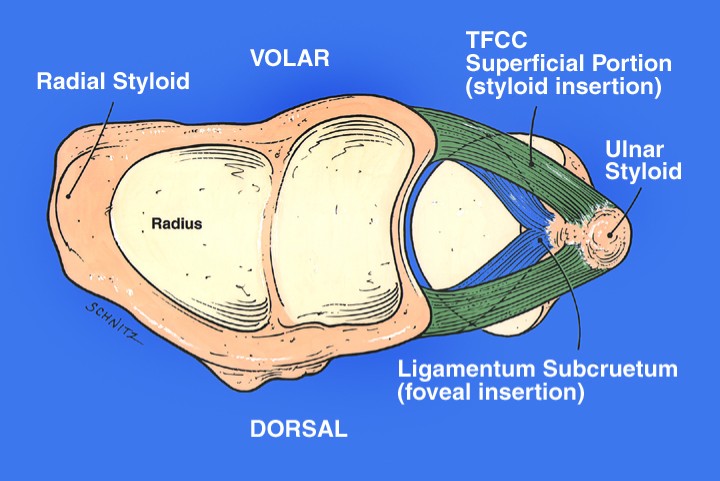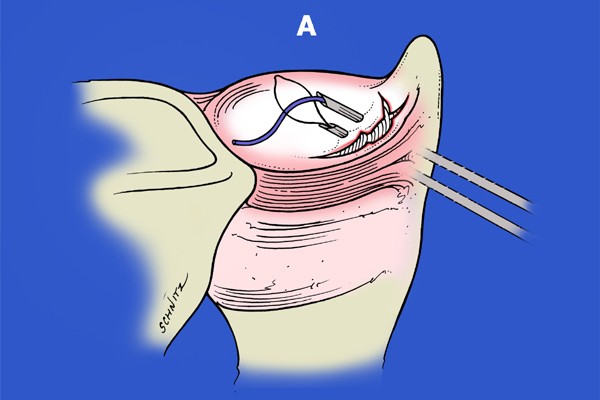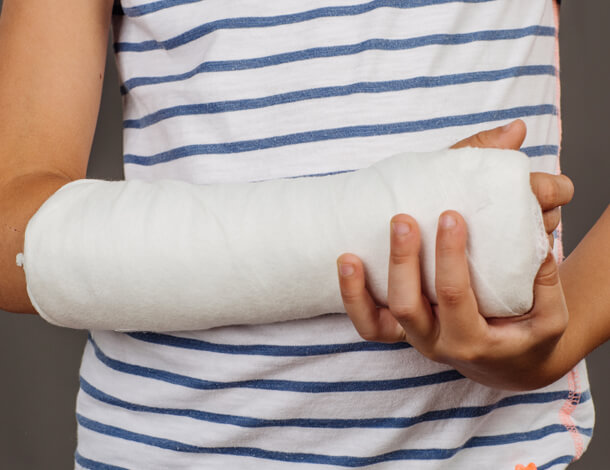Signs That a TFCC Tear Is Responsible for Your Wrist Pain

Turning a key, gripping a door knob, or writing by hand shouldn’t cause wrist pain. If you find yourself wincing while doing these everyday motions, you might have a TFCC tear. This ligament complex injury is commonly associated with pain in the outer wrist. It’s a typical result of using your hands to break a fall. Repetitive motions, hard twists, arm fractures, and age-related degeneration may also be contributing factors.
Many TFCC tears can heal without surgery. In some instances, however, the tear can worsen, become extremely painful, and sometimes seriously limit or prevent mobility. Nearly 50% of TFCC tears occur in people 70 and older.
Continue reading to learn about the primary symptoms of a torn TFCC and available treatment options.
What Is a TFCC Tear?
TFCC stands for triangular fibrocartilage complex. It’s a small set of ligaments that connect the wrist bones (the “carpals”), the forearm’s ulna and radius bones. The TFCC is located on the ulnar side of your wrist, also referred to as the pinky side or its outer edge when your palm is facing down.
Its job is to stabilize and cushion your wrist, allowing the joint to rotate, grip, and bear weight. A torn TFCC is a sprain associated with pronounced outer wrist pain when you make one of those actions.
Related Tear of TFCC Symptoms
A TFCC tear is a type of ulnar wrist joint sprain and produces consistent symptoms.
- Pain in your outer wrist
- Swelling
- Difficulty twisting and gripping
- Clicking or popping sensations when moving the wrist
- Feeling of instability
Actions Associated With TFCC Tear Pain
If you have a TFCC tear, you might notice pain in your outer wrist or entire wrist when making one of these ordinary movements:

- Twisting off a cap from a bottle
- Using a screwdriver
- Screwing in a light bulb
- Reaching for keys while typing
- Opening a jar
- Pushing up from a chair
- Moving your wrist in the direction of the pinky
What Causes a Torn TFCC
Many TFCC tears are associated with a fall, especially when individuals use their hands to catch themselves during a tumble, as this places extreme pressure on the wrists. This is considered an acute injury.
Other causes of TFCC tears include:
- Arm injuries: If you experience ulnar wrist joint pain after breaking or twisting an arm, it could be a sign that you also suffered a torn TFCC. One example of a common twisting injury that causes a TFCC tear is a drill bit that catches, wrenching the wrist.
- Degeneration: Wear and tear can cause your wrist tissue to break down, ultimately leading to your TFCC tearing. Degeneration also weakens your wrist, making it more susceptible to acute injury.
- Sports: Over-rotating your arm when participating in gymnastics, racket sports, baseball, or football can cause a TFCC tear.
- Disease: A tear may occur as a complication of gout or rheumatoid arthritis.
- Uneven bones: A person may be born with an ulna bone longer than the radius bone. This is known as an ulnar variance, and it can lead to a TFCC tear over time.
Types of TFCC Tears
A TFCC tear is an umbrella term for any injury to the components of the TFCC complex. The ligament could split, tear away from the bone, become perforated, or the cartilage could become damaged. Tears are categorized as either traumatic or degenerative, depending on their cause and location. Those factors may determine the best course of treatment.

- Class 1 traumatic tears: These tears result from an acute injury, such as a hard fall, forceful twisting motion, or another accident. A Class 1 tear may occur alongside a distal radius fracture, or lower arm bone break at the wrist.
- Class 2 degenerative tears: These chronic conditions develop gradually as a result of work-related wear and tear, aging, or excessive use. Additionally, tears typically classified as Class 2 are sometimes associated with having a mismatch in the length of the forearm bones near the wrist or pre-existing inflammatory conditions like gout and rheumatoid arthritis.
The Diagnosis Process
A physician typically begins by determining the cause of ulnar-sided wrist pain through a simple examination that assesses the fragility and sensitivity of the TFCC, particularly when twisting and gripping.
A telltale symptom of a TFCC tear is a “positive fovea sign,” which is tenderness in a specific spot in the wrist. Depending on the severity of the symptoms, further diagnosis may include:
- An X-ray to rule out a fracture
- An MRI to confirm or assess a diagnosis
- An arthroscopic procedure on the wrist for the most thorough examination of the injury
Complications Associated With Untreated TFCC Tears
Unless you stop gripping and twisting completely, a small tear can worsen until it becomes intolerably painful and severely limits daily function. A TFCC tear can eventually lead to permanent joint damage or arthritis. An early diagnosis can prevent significant pain, an interruption of work and activities you enjoy, and long-lasting physical complications.
Torn TFCC treatments
Minor TFCC tears can heal on their own if they aren’t interfering with daily activities. Still, you can speed up the recovery time by wearing a standard brace or a custom orthotic, taking anti-inflammatory medication (such as NSAIDs like naproxen and ibuprofen), resting your wrist, and possibly undergoing wrist therapy.
Therapy for TFCC Repair
An experienced hand therapist has specialized knowledge in treating TFCC tears non-interventionally. Exercises performed with a therapist or at home can help reduce pain and inflammation, increase stability and strength, restore function, and aid in avoiding surgery, ultimately reducing recovery time.
Other Treatments for TFCC Tears

If your torn TFCC fails to respond to conservative treatments or if you’ve been in a serious accident, steroid injections or surgery may be needed to help you heal. An experienced wrist specialist will talk to you about your options for care and help you figure out which treatment is right for you.
Arthroscopic Debridement Surgery
A debridement involves removing damaged tissue that cannot be repaired. The surgeon works through small incisions to take out the tissue. Debridements are usually recommended for degenerative, or Class 2, tears of the TFCC. Bracing and physical therapy are often part of the recovery process, which typically lasts four to six weeks.
Arthroscopic Repair Surgery
Tissue tears in areas with ample blood flow may be repaired instead of being removed. Class 1 injuries (like athletic injuries) are more suitable for repair than Class 2 tears. Bracing and physical therapy are often part of the recovery, which can take up to three months.
Open Surgery
Ligaments with complex tears or detached from the bone may require open surgery for better access to the TFCC. A cast may need to be worn after an open surgery, followed by physical therapy. Recovery may take six to 12 weeks.
FAQs About TFCC Tears
These are the top questions among patients concerned about TFCC tears.
How Can I Prevent a Tear of My Wrist’s TFCC?
Athletes and individuals in high-risk occupations, such as those in construction, should ensure they strengthen their wrist and forearm muscles to reduce the risk of injury. Wrist curls and grip exercises are good options. Consider wearing a wrist brace for extra support if you lift heavy objects to minimize strain on the TFCC or if you are at risk of falling.
If you play racket sports, make sure your equipment is best-suited to your body and style of play to minimize the risk of absorbing a harmful amount of wrist impact.
What Other Conditions Mimic a Torn TFCC?
Wrist pain and weakness can indicate a cartilage injury, wrist fracture, osteoarthritis, or a different type of ligament injury in the wrist. Chronic conditions, such as ulnar impaction (where the arm bone butts up against the wrist bones) and Kienböck’s disease (a wrist problem related to poor circulation), can also mimic TFCC tears. An expert diagnosis is crucial to determining the best course of treatment.
Will Cortisone Shots Fully Heal My Torn TFCC Injury?
No. A cortisone injection can reduce inflammation and provide pain relief, but may not be a permanent solution for ulnar wrist pain when twisting and gripping.
Is It Time to Seek Help for a TFCC Tear?
You should always see a doctor for severe pain that interrupts daily activities or if you suspect you have sustained an injury. But many causes of pain and weakness fall into a gray area of severity.
If you have sharp pain in the ulnar side of your wrist that doesn’t respond to icing, medication, and rest, or you aren’t sure what kind of brace or at-home treatment to try, it’s perfectly appropriate to talk to a wrist expert about a potential TFCC tear.
“I just can’t begin to tell you how happy I am with how everything turned out. I’m so grateful to Dr. Crosby and his team. I also could tell he knew what he was talking about and appreciated how he always went out of his way to make me feel at ease.”—Kirstie F., IHTSC hand and wrist pain patient
How We Can Help With TFCC Tears
The certified wrist specialists and hand therapists at Indiana Hand to Shoulder Center have extensive experience in providing successful treatment for ulnar wrist pain. With our advanced capabilities and comprehensive rehabilitation facility, we develop a personalized approach to treatment and recovery for each patient.
We’re dedicated to helping you live pain-free and enjoy your favorite activities with peace of mind. For world-class care, trust IHTSC’s team of wrist pain specialists.
Call (317) 743-3985 to book or request an appointment online.
You Might Also Like:
- Hamate Fractures: The Broken Wrist With a Twist
- What Actually Causes Hand Numbness and Pain
- Getting Ready for Your First Hand Therapist Appointment? Here’s What to Expect
Medically reviewed by Brandon Smetana, M.D., FAAOS
Disclaimer: The materials on this website have been prepared for informational purposes only and do not constitute advice. You should not act or rely upon any medical information on this website without a physician’s advice. The information contained within this website is not intended to serve as a substitution for a thorough examination from a qualified healthcare provider. The display of this information is not intended to create a health care provider-patient relationship between the Indiana Hand to Shoulder Center and you.



